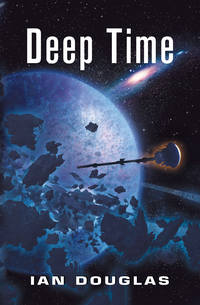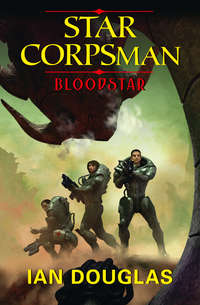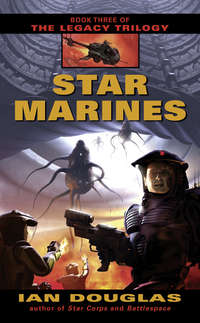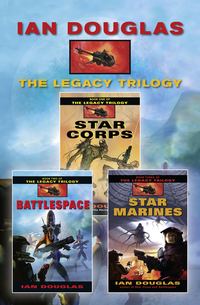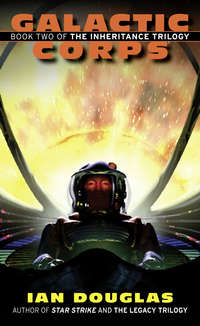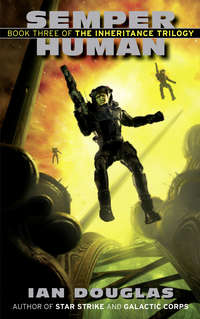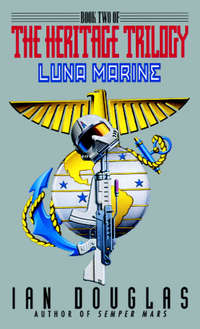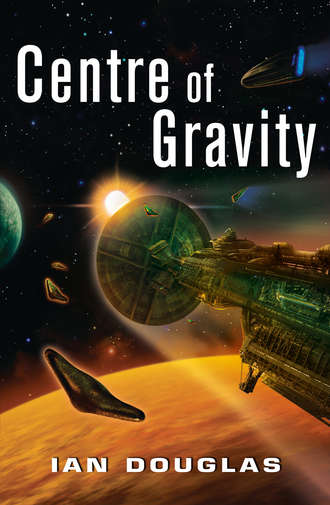
Полная версия
Centre of Gravity
He wished he could blow off the invitation entirely, though. He was busy working on a set of tactical evaluations with Fleet HQ, and he didn’t have time for this nonsense.
But for military personnel an invitation from the president of the Confederation Senate himself was an order, not a suggestion, and Fleet Admiral Rodriguez would be there as well.
Better to go and get the damned thing over with.
Another chime sounded, and this time Karyn’s image appeared, his personal assistant serving now as his secretary.
“What is it, Karyn?” he asked.
“An incoming fleet communication, Alex,” she said. “You’re really going to want to see this.”
“Put it through.”
A window opened in his mind, and he felt the flow of the encrypted data feed. Keys within his implanted circuitry opened the message, and he found himself looking down on another world.
“ONI/DeSpaComCent to all units with Crystal Tower clearance and above,” an emotionless voice, probably an AI, said. “We have an incoming transmission from an ISVR–120 dispatched to the Arcturus system six weeks ago. Data is raw, with only preliminary analyses by this department. …”
Within his mental window, Koenig could see the planet and its moon. A cascade of printed data scrolled down one side of his awareness, but he didn’t need to read it to recognize the gas giant Alchameth and its largest satellite, Jasper. A bright blue targeting reticule marked a silvery pinpoint—Arcturus Station in orbit over a cloud-swathed moon. A dozen smaller reticules, each bright red, marked Turusch ships in orbit around Jasper.
His experienced inner eye took in the Turusch ships, each with its id tag giving type, mass, and readiness. Two Beta-class battlewagons, plus at least ten cruisers, light cruisers, and destroyers. That was a fair-sized battle fleet, and suggested that the Turusch were waiting for a possible Confederation counterattack into the system.
Not that that was going to happen anytime soon. Confederation Fleet Command had been reluctant to re-engage the enemy. The Defense of Earth might technically have been a victory, but it had been a damned close-run thing.
The gas giant, simmering in the sea of radiation from giant Arcturus just 20 AU distant, showed the bright yellow, orange, red, and brown striations of atmosphere belts, whipped around the massive planet by violent high-altitude winds.
The scene moved jerkily, frame by frame, and the images were grainy and difficult to resolve. They would have been pulled from a seemingly uniform starbow of light by sensory correction software on the probe, and, as the voice had warned, hadn’t yet been massaged by the ONI analysts on Luna. But as the probe moved past planet and moon, the moon dropped from view outside of the camera angle and the probe’s optics began zooming in on Alchameth.
Another blue reticule appeared, highlighting something above the banded cloud tops. Koenig resisted the impulse to squint, patiently waiting as the images—drastically slowed by the relativistic time difference between the probe and the outside world—zoomed in frame by frame.
There was something there. …
Sunlight glinted, a silver-orange glitter above orange clouds. A spacecraft? The probe’s optical sensors zoomed in closer. It looked like a flattened balloon, but it must have been immense to be visible at this range, many kilometers across. And it was rising above the highest cloud layers, now, so it must be a ship … or possibly an aircraft.
A side window opened, showing schematics of a H’rulka ship, something encountered by humans only once so far.
Turusch and H’rulka ships together at Arcturus, just 37 light years from Sol.
The afternoon, suddenly, had become a lot more interesting.
VFA–44 Dragonfire Squadron
Approaching Columbia Arcology
United States, Earth
1655 hours, EST
Lieutenant Trevor Gray descended above the ocean, dropping toward the ruin of Old New York.
Linked in with the AI computer of his SG–92 Starhawk, his cerebral implants were receiving optical feeds from sensors grown temporarily all over the craft’s fuselage. From his point of view, his fighter was invisible—in fact, he was the fighter, hurtling through the early evening sky off the eastern seaboard of the United States. The winter sun had set twenty-five minutes before; the sky was still a crisp and brilliant blue, the twilight illuminating the dark rolling waves below.
Around him, in the crystalline sky, eleven other Starhawks traveled with him in close formation, each jet-black ship now morphed into atmospheric flight mode—broad delta shapes with down-curving wingtips carving through thin air at a sedate four times the speed of sound. They’d departed from the military spaceport at Oceana just five minutes earlier, swinging far out over the ocean to avoid disturbing coastal communities with their sonic boom. The Manhat Ruins now lay only a few kilometers ahead.
“Look smart,” the squadron leader said over the unit’s tactical channel. “They want a nice show down there. Cut back to fifteen hundred kph and descend to twelve hundred. Tighten it up, people.”
Commander Marissa Allyn was the CO of VFA–44, the “Dragonfires,” and flying the lead Starhawk, hull number 101. Until recently, she’d been the CAG of America’s Space Wing, though she’d never been confirmed and, just days ago, a new CAG had been brought on board. America’s fighter wing was still reorganizing, still licking its wounds after the terrible casualties suffered during the Defense of Earth.
In three groups of four flying wingtip to wingtip, the Starhawks dropped closer to the blur of blue-gray water beneath their keels.
“And … descending to eight hundred meters,” Allyn continued.
To port, Gray was aware of a smear of movement, the coastline of the old state of New Jersey, a stretch of ground until recently given over to swampland and mangrove but now swept clean, barren and forbidding. Still descending, they rocketed past the sweeping, broken curve of the Verrazano Narrows Dam, one of the megastructures raised in the twenty-first century in what had proven to be an expensive but unsuccessful bid to save the city ahead.
Still slowing, still descending, the squadron passed over what was left of New York City.
Forests of steel superstructure marking the largest building, the crumbling façade of the TriBeCa Tower, all rose above dirty, surging water. Vine-shrouded structures slowly eroding into the sea. Where once there had been a square-grid network of city streets, there were now narrow canals, canyons filled with water and the dark pockets of the coming night.
New York City had first been submerged three centuries before, when Hurricane Cynthia had smashed a half-kilometer gap through the Verrazano Narrows Dam and the sea—now twelve meters higher than the southern tip of Manhattan—had poured in. The vibrant metropolis had been smashed, then drowned; the shattered buildings still standing had rapidly crumbled into decayed ruins or been overgrown by green masses of porcelain-berry, kudzu, and other creeping vines, giving them the look of sheer-sided green islands rising with a curiously geometric orderliness from the sea.
Even so, the Ruins of Manhattan had been … home.
Gray had been a Prim, one of some thousands of people living in the Ruins outside the all-encompassing embrace of modern technology. For him, until five years ago, home had been the shattered shell of the old TriBeCa Tower Arcology, a torn and battered mountain passing now to port.
The scene, spread out around and below him now, however, illuminated by the pale glow of twilight, seemed alien now. The place was changed, shockingly so. During the Defense of Earth two months earlier, a Turusch high-velocity impactor had generated a tidal wave that had smashed north through the Narrows. Hundreds of the remaining buildings sticking up out of the water had been toppled, and a vast forest of tangled debris was now strewn across Morningside Heights, Yonkers, and the swamps of Harlem. Most of the building-islands, once covered by lush vegetation, were naked now, stripped of all life by the passing wave two months before.
Thousands of people—Prims and squatties, like Gray in his former life—had lived within the ruins, comprising a modern-day hunter-gatherer society largely ignored by the civilized folk inland.
Gray wondered how many had survived the tidal wave … how many of the people he’d once called family and friends survived.
And the civilized communities here had suffered as well. The tidal wave had swept across Morningside Heights, bringing down the kilometer-high tower of the Columbia Arcology. An instant after crossing the shoreline between the Manhat Ruins and Morningside Heights, Gray saw the mountain of rubble that was all that was left of Columbia.
Angela. …
She hadn’t been there when the tower had fallen. At least, he didn’t think so.
But he hadn’t heard, not for sure.
He forced his thoughts from that pain, focusing instead on his flying. At just above the speed of sound, the twelve spacecraft thundered across the Hudson River and past the Palisades Eudaimonium precisely on schedule.
The eudaimonium—the name came from the ancient Greek philosophical concept of perfect and complete happiness—was part of the Greater New New York complex north of Manhattan. Protected from the impactor tidal wave two months before by the towering walls of the Palisades overlooking the Hudson, it was the heart of the New City, a cluster of arcology towers, arches and skyways, domes, slabs, and floater habs housing 5 million people. Tonight, the local population had increased by at least a third. As the Starhawks roared past, Gray could see the lights and thronging crowds below, an ocean of people celebrating what had been rather grandiloquently billed as the “Yule of the Millennium.” The central Eudaimon Plaza appeared to be packed with celebrants; lasers arced across the sky amid the flicker and pop of fireworks. Tens of thousands of decorative lights created the impression of a galaxy picked out in reds, greens, and golds.
“Landing lights, people!” Allyn commanded, and the squadron lit up, twelve dazzling stars streaking across the darkening sky at five hundred meters. The sonic boom of the squadron’s passing must have rattled walls and transplas windows ten kilometers away.
The squadron over-flight had been timed to rattle those windows at seventeen precisely, kicking off the festivities at the arcology complex. Confederation Senate President Regis DuPont was down there, somewhere, as were the presidents of the North American Union, America del Sur, and Europe; a dozen Confederation senators; a host of VIPs from the military, from the Union capital at Columbus, Ohio; and even a handful of governors from extrasolar colony worlds—from Chiron, from Thoth, and even from Bifrost.
The party tonight was a very big affair.
Mission accomplished, the squadron banked and decelerated, making for the Giuliani Spaceport northwest of the city. A flotilla of civilian pubtran fliers was waiting for them there; the Dragonfires, too, had also been invited, though they’d be arriving at the party a few minutes late.
As he peeled off for final approach, morphing his Starhawk into landing configuration, Gray could only think about the person he’d left behind …
… About Angela.
ONI Special Research Division
Crisium, Luna
1201 hours, TFT
“What the hell do we know about the H’rulka?” Dr. Kane demanded.
“Not enough,” Wilkerson replied. “Not enough by about fifteen hundred parsecs.”
“Maybe your pets can shed some more light on the subject.”
“They are not,” Wilkerson replied evenly, “my pets.”
Until two months before, Dr. Phillip Wilkerson had been the head of the neuropsytherapy department on board the Confederation Star Carrier America. After the return from Eta Boötis, however, he’d been summarily transferred to the Office of Naval Intelligence—specifically to the xenosophontological research department, headquartered beneath the Mare Crisium on Earth’s moon. He’d brought with him eighteen Turusch POWs, and almost two thousand more had arrived shortly after—survivors of one of the big enemy asteroid-battleships disabled in the Defense of Earth.
The Turusch community now comprised a de facto alien colony occupying a former warehouse excavation two kilometers beneath the main Crisium dome, sealed off by airlocks and pumped full of a high-pressure atmosphere composed of CO2, sulfur dioxide, carbonyl sulfide, water vapor, sulfuric acid droplets, and a mist of sulfur. The mist constantly cycled between its liquid and solid phases at temperatures close to the boiling point of water. The Turusch home planet was hypothesized to be, as Wilkerson himself had once suggested, a less extreme version of the planet Venus, with a thinner atmosphere bathed in heavy ultraviolet radiation from its parent star. For almost two months, Wilkerson had been working with the colony, leading a small army of xenosophontologists, linguists, and ETC AIs, trying to learn how the Turusch thought.
The task, he’d long ago decided, would not be complete anytime in this century.
Dr. Howard Kane was one of his project specialists, on loan from the ONI’s XS department. An unpleasant man with an acidly sarcastic attitude, he seemed to specialize in finding exactly the wrong thing to say to his colleagues. Wilkerson so far had managed to keep him from communicating directly with the Turusch. That task was difficult enough without bringing ego and attitude into the mix.
“This Crustal Tower message,” Kane said, “says a H’rulka ship has been spotted at Arcturus Station. “But as far as I can see, we don’t know jack about them.”
“The Turusch have mentioned the H’rulka during a number of sessions,” a third voice put in. “They state that the two species share key philosophical concepts.”
The invisible speaker was a specialist AI variously called Noam or, sometimes, “Chom,” after the twentieth-century linguist, cognitive scientist, and philosopher Avram Noam Chomsky.
“There was nothing else in Alan’s recording?” Wilkerson asked.
“No. The AI known as ‘Alan’ effectively ceased to exist upon partition.”
Wilkerson nodded understanding. An artificial intelligence like Noam, or like the smaller and more mission-specific AI on the Arcturus recon probe, required a certain size, a certain complexity of internal circuitry and processing power in order to maintain the electronic version of consciousness. Details were still sketchy, but the ISVR–120 interstellar probe apparently had elected to split itself into four separate parts. The probe hardware was designed to allow such a division in order to guarantee that its memory made it back home … but the circuitry carrying those memories simply wasn’t adequate to maintain something as complex as a Gödel 2500 artificial intelligence.
The AI Alan Turing had in effect committed suicide in order to get its information back to Sol.
Kane dragged down a virtual window, which glowed in the air in front of him and Wilkerson. The data file with what little was known about the H’rulka scrolled down the screen. “Floaters!” Kane said, reading. “The presumption is that they’re intelligent gas bags that evolved in the upper atmosphere of a gas giant.”
“Interesting, if true,” Wilkerson said, reading. “I’d like to know how they managed to develop a technology capable of building starships without access to metals, fire, smelting, solid raw materials, or solid ground.”
“What is it they’re supposed to share with the Tushies, Chom?” Kane asked.
“It is difficult to express,” Noam replied, “as are most Turusch concepts. It appears, however, to be a philosophy based on the concept of depth.”
“Yeah, yeah. They order things higher to lower, instead of the way we do it.”
“It’s no different than when we say something is second class,” Wilkerson said, “and mean it’s not as important or as high-up as first class.”
“It’s still bass-ackward,” Kane said.
“The three conscious minds of a Turusch are considered by the Turusch to range from ‘high’ to ‘here’ to ‘low,’” Noam pointed out, “with ‘high’ being the most primitive, most basic state of intelligence, and ‘low’ the most advanced and complex. For the Turusch, something called the Abyss represents depth, scope, danger, and tremendous power. We think the Turusch evolved to live on high plateaus or mountaintops on their world, with lower elevations representing sources of wealth or power—maybe a food source—as well as deadly windstorms. Abyssal whirlwinds, they call them.”
“So, if the H’rulka are Jovian-type floaters,” Wilkerson mused, “they might relate to the idea of the Abyss as the depths of a gas giant atmosphere. Hot, stormy, high energy, and definitely dangerous. A point of cognitive contact or understanding between them and the Turusch.”
“Sounds far-fetched to me,” Kane said. “Besides, intelligence couldn’t develop in a gas giant atmosphere. Absolutely impossible.”
“I’ve learned in this business to mistrust the phrase ‘absolutely impossible,’ Doctor,” Wilkerson said. “Why do you think that?”
“Because the vertical circulation of atmospheric cells in a gas giant atmosphere would drag any life form in the relatively benign higher levels down into the depths in short order,” Kane replied. “They would be destroyed by crushing pressures and searing high temperatures. There’d be no way to preserve culture … or develop it, for that matter. No way to preserve historical records … art … music … learning. And, as you just said, they wouldn’t get far without being able to smelt metals or build a technology from the ground up.” He smirked. “No ground.”
“But we do have lots of examples of Jovian life,” Wilkerson said.
“None of it intelligent,” Kane replied. “It can’t survive long enough.”
“Maybe.” Wilkerson moved his hand, and the columns of writing on the virtual window were replaced by the image received by the ONI a few hours before … a transmission from a burned-out interstellar probe that had dropped into the outskirts of the Sol System and beamed its treasure trove of data in-system that morning.
An alert with raw-data footage had been passed on to a number of government offices and military commands a few hours ago; the fact that the H’rulka were at Arcturus was big news. It meant, potentially, disaster. …
“Whether they’re gas bags from a Jovian atmosphere, or something more substantial,” Wilkerson observed, “they mean trouble. We’ve only met them once, but that was enough.”
The ongoing exchange of hostilities known as the First Interstellar War had been proceeding off and on for the past thirty-six years. It had begun in 2368 at the Battle of Beta Pictoris, with a single Terran ship surviving out of a squadron of eight. In the years since, defeat had followed defeat as the Turusch and their mysterious Sh’daar masters had taken world upon human-colonized world, as the area controlled by the Terran Confederation had steadily dwindled.
Most of those defeats were suffered by Earth’s navies at the hands the Turusch va Sh’daar, a species that appeared to be the equivalent of the Sh’daar empire’s military arm. Once, however, a dozen years ago, a Confederation fleet approaching a gas giant within the unexplored system of 9 Ceti, some 67 light years from Sol, had been wiped out by a single enormous vessel rising from the giant’s cloud layers. A single message pod had been launched toward the nearby human colony of Anan, just seventeen light years away, at 37 Ceti.
The Agletsch, the spidery sentients who’d been Humankind’s first contact with other minds among the stars, had looked at images from that pod and identified the lone attacking ship as H’rulka. The name was an Agletsch word meaning, roughly, “floaters.” They’d claimed that the aliens were huge living balloons that had evolved within the upper atmosphere of a distant gas giant like Sol’s Jupiter. The term H’rulka va Sh’daar suggested that the H’rulka, like the Turusch and like the Agletsch, were part of the galaxy-spanning empire of the Sh’daar.
No one knew what the H’rulka called themselves, what they looked like, or anything at all about them. Many human researchers, like Kane, were convinced that even the information about a gas giant homeworld was either mistaken or deliberate misinformation.
What was known was that a few weeks after the fleet at 9 Ceti was lost, all contact with Anan was lost as well.
If the H’rulka were at Arcturus, apparently working with the Turusch, it suggested that the Sh’daar had just upped the ante, bringing up some big-gun support for their Turusch allies.
“We could start talking to our Turusch about whether they’ve worked with the H’rulka before,” Wilkerson suggested. “It might give us some insight into how they fit in with the Sh’daar hierarchy.”
Three millennia earlier, Sun Tse had pointed out that a man who knew both himself and his enemy would be victorious in all of his battles. That might have worked for the ancient Chinese, but complete knowledge simply wasn’t possible—certainly not of beings as completely alien as the Sh’daar, the H’rulka, or the Turusch.
“Do you think that’s important?” Kane asked.
Wilkerson shrugged. “At this point, every datum is important. We’re not even sure why they’re attacking us.”
“I thought it was because the Sh’daar wanted to limit our technological growth.”
“So the Agletsch told us. But how accurate is that? And if it is, why? We call the Sh’daar polity an empire … but is it? Do the Sh’daar really control all of their client species, tell them what to do, who to trade with, who to attack? Or are the Turusch, and now the H’rulka, attacking us on their own? We don’t know.”
“The term empire serves well enough,” Kane said. “We may not need to know the details.”
“Maybe not … but we won’t know what we need to know until we winkle it out, translate it, and analyze it.”
“Well, let’s see what the slugs have to say,” Kane agreed.
“You don’t sound very enthusiastic.”
“Enthusiastic? No. Those big gastropods give me the creeps. I keep wanting to reach for the salt shaker … a very large salt shaker. …”
Chapter Two
21 December 2404
Palisades Eudaimonium
New York State, Earth
1725 hours, EST
The spaceport’s pubtran flier touched down lightly on the landing platform, a broad concourse suspended several hundred meters above the ground in front of the Grand Concourse. Trevor Gray stepped out of the flier and stopped, momentarily transfixed by the spectacle below, a dazzling constellation of lights stretching from horizon to horizon. Near at hand, concentric circles of lights, illuminated buildings, glowing red and green holiday decorations and animations, and the shifting displays of adwalls all combined to create a bewildering tangle of moving light. In the distance, toward the southeast, lay an ominous swath of darkness punctuated by the light—Columbia, Manhattan, and on the horizon, the ocean.
Someone thumped his shoulder hard from behind.
“Move it, Prim,” Lieutenant Jen Collins snapped. “You’re blocking progress.”
Gray turned sharply, fists clenched, but then stepped aside as the others filed out of the flier. Lieutenant Commander Allyn was coming off the flier last, and was watching him. “Uniform, Lieutenant,” she reminded him. “This is a formal affair.”
“Ah, you should have let the Prim wear his jackies,” Collins said with a bitter laugh.
“Yeah,” Lieutenant Kirkpatrick added, grinning. “The dumb-ass doesn’t know any better. It’ll be fun watching him try to mix with our kind.”




